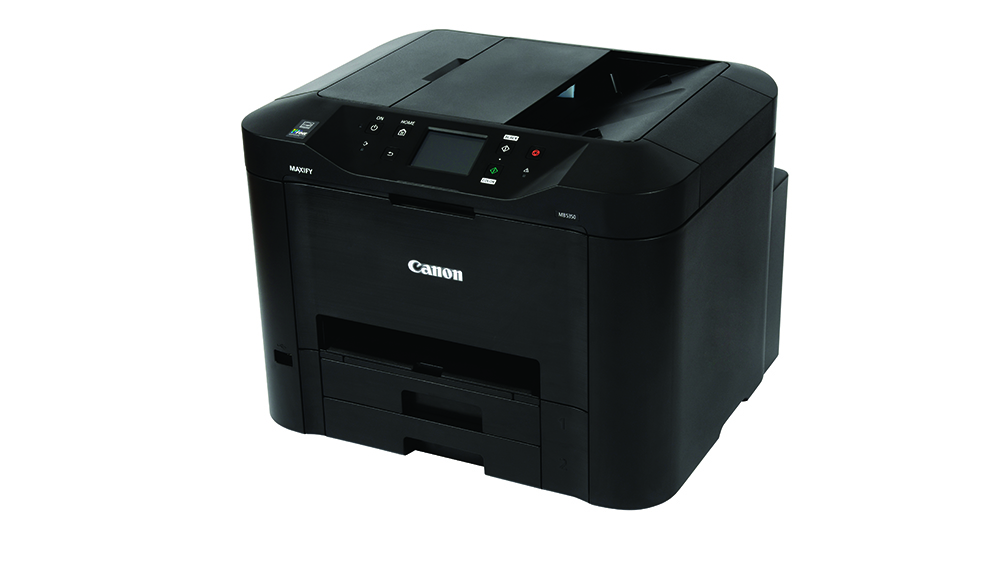Canon Maxify MB5350 review
An upmarket inkjet that takes on the lasers – and, in many areas, manages to beat them


Versatile paper-handling and excellent document-scanning capabilities make the MB5350 an excellent choice. If you’re in the market for an affordable laser printer, don’t rule out this impressive offering.
-
+
Affordable cost-per-page; Superb scan speeds; Good colour printing;
-
-
Ceases printing if one colour runs out; Scanning speed and quality is patchy;

At first glance the Maxify MB5350 looks like a bog-standard office laser printer. In reality, this inkjet is designed to not only resemble a laser but do the work of one, with Canon targeting home offices and small groups that don't need to shell out for the real thing.
At first glance, that might seem a bit backwards: at 170, the Maxify is more expensive than many printers in a similar bracket. But for the money you get some upmarket features those models can't match: twin 250-sheet paper cassettes come as standard, as does a 50-sheet duplex ADF for double-sided scanning. And it's all controlled from a friendly 7.5cm colour touchscreen interface that literally puts all the Maxify's features at your fingertips.
As usual, inkjet output can't match the crispness of laser-printed text, but even at standard settings the Maxify's output is pretty clean and Canon's black ink looks agreeably solid on the page. It comes out quickly, too: our 20-page test document was completed at an average of 16ppm, faster than any other inkjet, and quicker even than some lasers.
Graphical output is also a strength: solid blocks of colour have depth and richness to them, while gradients and photos look smooth and natural. But the printer isn't superfast for this type of output: our five-page business document came out at an average of 6.3ppm. Our high-quality photomontage took 70 seconds to print. Still, if you just need to produce the occasional colour image, the Canon is a fine choice.
Scanning is a mixed bag. Pictures don't come across particularly fast: an A4 image took 54 seconds to scan at 300ppi over our wireless network. Colour reproduction was very good, but images came out with a speckly character, which was exacerbated by the heavy sharpening applied by default. Turning this off smoothed things over, but curves and fine details still looked somewhat ragged next to the output from rival printers.
When it comes to document scanning, however, the Maxify is a winner. A 200ppi greyscale PDF came down the line in just 14 seconds, and when you load up the ADF things get faster still. Our ten-page document was digitised in less than a minute, and since the Maxify has a double-sided scan head, 20 double-sided pages took a mere five seconds longer.
The Maxify MB5350 does commit one major foul: if any one of your colour cartridges runs out, it will abruptly stop printing and refuse to go again until it's replaced. Many other inkjets let you carry on printing in black, at least for a certain period, while you order a new ink supply - a much more user-friendly way to do things.
Happily, the replacement price of these cartridges is very reasonable indeed. Mono text works out to an easy-to-swallow 1.1p per page, with colour coming in at 5.2p per page. Very few lasers can compete with such low prices, especially not for colour: the MB5350 costs 20 more than the Lexmark CX310dn, but after just 250 colour prints you'll have saved money by choosing it.
Overall, the Maxify ticks a lot of boxes. The Brother MFC-J5620DW pips it for sheer value, and throws in the tempting bonus of A3 support, but for a busier office, the MB5350's more versatile paper-handling and excellent document-scanning capabilities make it a better choice overall. If you're in the market for an affordable laser printer, don't rule out this impressive alternative.
This review originally appeared in PC Pro issue 262
Verdict
Versatile paper-handling and excellent document-scanning capabilities make the MB5350 an excellent choice. If you’re in the market for an affordable laser printer, don’t rule out this impressive offering.
Get the ITPro daily newsletter
Sign up today and you will receive a free copy of our Future Focus 2025 report - the leading guidance on AI, cybersecurity and other IT challenges as per 700+ senior executives
Darien began his IT career in the 1990s as a systems engineer, later becoming an IT project manager. His formative experiences included upgrading a major multinational from token-ring networking to Ethernet, and migrating a travelling sales force from Windows 3.1 to Windows 95.
He subsequently spent some years acting as a one-man IT department for a small publishing company, before moving into journalism himself. He is now a regular contributor to IT Pro, specialising in networking and security, and serves as associate editor of PC Pro magazine with particular responsibility for business reviews and features.
You can email Darien at darien@pcpro.co.uk, or follow him on Twitter at @dariengs.
-
 Westcon-Comstor and Vectra AI launch brace of new channel initiatives
Westcon-Comstor and Vectra AI launch brace of new channel initiativesNews Westcon-Comstor and Vectra AI have announced the launch of two new channel growth initiatives focused on the managed security service provider (MSSP) space and AWS Marketplace.
By Daniel Todd Published
-
 Third time lucky? Microsoft finally begins roll-out of controversial Recall feature
Third time lucky? Microsoft finally begins roll-out of controversial Recall featureNews The Windows Recall feature has been plagued by setbacks and backlash from security professionals
By Emma Woollacott Published
-
 The UK government wants quantum technology out of the lab and in the hands of enterprises
The UK government wants quantum technology out of the lab and in the hands of enterprisesNews The UK government has unveiled plans to invest £121 million in quantum computing projects in an effort to drive real-world applications and adoption rates.
By Emma Woollacott Published